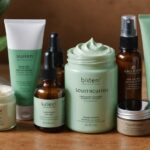Determining your skin type is crucial for effective skincare and maintaining a healthy complexion. Your skin can fall into several categories: oily, dry, combination, normal, or sensitive. This guide will help you easily identify your skin type through a series of straightforward methods, empowering you to select the appropriate products that suit your unique skin needs. By understanding your skin type, you can achieve better results with your skincare routine and avoid the frustration of using products that are not meant for you.
Why Knowing Your Skin Type Matters

Understanding your skin type is foundational to developing a successful skincare routine. Different skin types react to products in varying ways; therefore, knowing your type allows you to choose the right cleansers, moisturizers, and treatments. For example, an oily skin type may benefit from lightweight, oil-free products, while those with dry skin may need thicker creams that provide extra hydration. Furthermore, selecting products that align with your skin type can help prevent common issues such as breakouts, dryness, and irritation. A tailored skincare routine not only enhances the appearance of your skin but also promotes its overall health, reducing the risk of age-related concerns.
How to Identify Your Skin Type

Identifying your skin type may seem intimidating, but it can be done through simple observations and tests. Here’s a straightforward approach to determining your skin type:
- The Bare-Faced Test: Start with a clean face. Thoroughly wash and gently pat your skin dry. Leave your skin bare without applying any products for about an hour.
- Observation Phase: After an hour, observe how your skin feels. Take note of any shine, dryness, or sensitivity.
- Touch Test: Feel your skin with your fingertips. Is it rough, smooth, oily, or tight? Make a note of these sensations.
- Blotting Sheet Method: Use a blotting sheet on various areas of your face (forehead, nose, cheeks, chin). This will help determine how much oil is being produced in these areas.
Understanding Each Skin Type
Once you’ve completed your observations, it’s time to categorize your skin into one of the following types:
- Normal Skin: Characterized by balanced oil and moisture levels, this skin type rarely experiences breakouts or dry patches. It has a smooth, even texture.
- Oily Skin: This type often appears shiny and may be prone to acne. The skin produces excess sebum, leading to enlarged pores.
- Dry Skin: Often feels tight, rough, and may have visible flakiness. It lacks moisture and can be more susceptible to wrinkles.
- Combination Skin: A mix of oily and dry areas, commonly characterized by an oily T-zone (forehead, nose, and chin) and dry cheeks.
- Sensitive Skin: This type often feels irritated or reactive to products, leading to redness, burning, or itching. It requires gentle care.
Choosing the Right Skincare Products
Once you’ve identified your skin type, choosing the right products is essential. Each skin type has specific needs that must be addressed. Here are some product recommendations:
- Oily Skin: Look for oil-free or non-comedogenic moisturizers and lightweight gels. Incorporate exfoliating ingredients like salicylic acid to help clear breakouts.
- Dry Skin: Opt for rich creams and hydrating serums containing ingredients like hyaluronic acid, glycerin, and ceramides to lock in moisture.
- Combination Skin: Use a balanced moisturizer and focus on lighter textures in the T-zone while providing more hydration in drier areas.
- Normal Skin: Stick to a gentle cleanser and a light moisturizer; consider using a tinted sunscreen for added protection.
- Sensitive Skin: Choose fragrance-free products and keep it simple with minimal ingredients to reduce the risk of irritation.
Establishing a Skincare Routine
Having a personalized skincare routine is vital for maintaining healthy skin. Your regimen should reflect your specific skin type and any particular concerns you might have. Here’s a straightforward framework for creating your routine:
- Cleansing: Start with a gentle cleanser suitable for your skin type to remove dirt and impurities.
- Toning: Use a toner to help balance your skin’s pH and hydrate.
- Serum: Incorporate a serum that targets your specific concerns, whether it’s hydration, anti-aging, or acne.
- Moisturizing: Always apply a moisturizer to keep your skin hydrated. Adjust this based on your skin type.
- Sunscreen: Every routine should end with SPF protection, even on cloudy days.
Conclusion
Finding your skin type is a crucial first step in establishing a personalized skincare routine. By understanding your skin’s needs, you can choose the most suitable products that will enhance your natural beauty and improve your skin’s health. Remember that skincare is about consistency and care, so give your routine time to work. With the right information and products at your disposal, you’re well on your way to achieving the glowing, healthy skin you deserve.
FAQs
1. Can my skin type change over time?
Yes, your skin can change due to factors like age, hormonal shifts, climate changes, and lifestyle habits. Regularly assess your skin type to adjust your skincare regimen accordingly.
2. How often should I cleanse my face?
It’s recommended to cleanse your face twice daily—once in the morning and once before bed. This helps remove impurities that can lead to breakouts.
3. Is it okay to use multiple products for different skin types?
Yes! If you have combination skin, you can use different products on various areas of your face. Just ensure they work well together and do not irritate your skin.
4. What ingredients should I avoid if I have sensitive skin?
Avoid products with alcohol, synthetic fragrances, or harsh exfoliants. Instead, look for calming ingredients like aloe vera, chamomile, and centella.
5. How do I know if the product is non-comedogenic?
Non-comedogenic products are specifically formulated to not clog pores. Check labels and ensure a product is labeled as such before purchasing, especially if you have oily or acne-prone skin.


